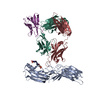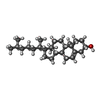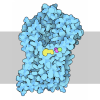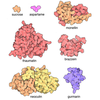+ Open data
Open data
- Basic information
Basic information
| Entry | Database: PDB / ID: 9.0E+82 | |||||||||||||||||||||||||||||||||||||||
|---|---|---|---|---|---|---|---|---|---|---|---|---|---|---|---|---|---|---|---|---|---|---|---|---|---|---|---|---|---|---|---|---|---|---|---|---|---|---|---|---|
| Title | ACKR3 phosphorylated by GRK5 in complex with arrestin2 and Fab7 | |||||||||||||||||||||||||||||||||||||||
 Components Components |
| |||||||||||||||||||||||||||||||||||||||
 Keywords Keywords | SIGNALING PROTEIN/IMMUNE SYSTEM / complex / GPCR / arrestin / signaling / SIGNALING PROTEIN-IMMUNE SYSTEM complex | |||||||||||||||||||||||||||||||||||||||
| Function / homology |  Function and homology information Function and homology informationTGFBR3 regulates TGF-beta signaling / oculomotor nerve development / positive regulation of mesenchymal stem cell migration / MAP2K and MAPK activation / Activation of SMO / telencephalon cell migration / chemokine (C-X-C motif) ligand 12 signaling pathway / Golgi Associated Vesicle Biogenesis / negative regulation of leukocyte tethering or rolling / response to ultrasound ...TGFBR3 regulates TGF-beta signaling / oculomotor nerve development / positive regulation of mesenchymal stem cell migration / MAP2K and MAPK activation / Activation of SMO / telencephalon cell migration / chemokine (C-X-C motif) ligand 12 signaling pathway / Golgi Associated Vesicle Biogenesis / negative regulation of leukocyte tethering or rolling / response to ultrasound / Lysosome Vesicle Biogenesis / regulation of actin polymerization or depolymerization / chemokine receptor binding / C-X-C chemokine binding / AP-2 adaptor complex binding / CXCL12-activated CXCR4 signaling pathway / Ub-specific processing proteases / clathrin coat of coated pit / clathrin heavy chain binding / CXCR chemokine receptor binding / Cargo recognition for clathrin-mediated endocytosis / C-X-C chemokine receptor activity / positive regulation of axon extension involved in axon guidance / desensitization of G protein-coupled receptor signaling pathway / positive regulation of vasculature development / positive regulation of dopamine secretion / Signaling by ROBO receptors / Clathrin-mediated endocytosis / induction of positive chemotaxis / integrin activation / clathrin-dependent endocytosis / negative regulation of dendritic cell apoptotic process / C-C chemokine receptor activity / negative regulation of intrinsic apoptotic signaling pathway in response to DNA damage / cellular response to chemokine / chemokine-mediated signaling pathway / C-C chemokine binding / acetylcholine receptor binding / G protein-coupled receptor internalization / positive regulation of monocyte chemotaxis / inositol hexakisphosphate binding / chemokine activity / blood circulation / Chemokine receptors bind chemokines / scavenger receptor activity / Thrombin signalling through proteinase activated receptors (PARs) / G alpha (s) signalling events / clathrin binding / small molecule binding / positive regulation of calcium ion import / pseudopodium / detection of temperature stimulus involved in sensory perception of pain / phosphatidylinositol-3,4,5-trisphosphate binding / positive regulation of receptor internalization / negative regulation of Notch signaling pathway / animal organ regeneration / detection of mechanical stimulus involved in sensory perception of pain / positive regulation of T cell migration / vasculogenesis / Nuclear signaling by ERBB4 / coreceptor activity / clathrin-coated pit / positive regulation of endothelial cell proliferation / positive regulation of neuron differentiation / positive regulation of cell adhesion / axon guidance / adult locomotory behavior / cell chemotaxis / growth factor activity / calcium-mediated signaling / defense response / G protein-coupled receptor binding / response to peptide hormone / recycling endosome / receptor internalization / response to virus / integrin binding / positive regulation of protein phosphorylation / neuron migration / intracellular calcium ion homeostasis / chemotaxis / protein transport / : / positive regulation of cytosolic calcium ion concentration / cytoplasmic vesicle / ubiquitin-dependent protein catabolic process / angiogenesis / G alpha (i) signalling events / molecular adaptor activity / Estrogen-dependent gene expression / early endosome / response to hypoxia / positive regulation of ERK1 and ERK2 cascade / cell adhesion / endosome / immune response / positive regulation of cell migration / G protein-coupled receptor signaling pathway / signaling receptor binding / negative regulation of cell population proliferation Similarity search - Function | |||||||||||||||||||||||||||||||||||||||
| Biological species |   Homo sapiens (human) Homo sapiens (human)synthetic construct (others) | |||||||||||||||||||||||||||||||||||||||
| Method | ELECTRON MICROSCOPY / single particle reconstruction / cryo EM / Resolution: 3.4 Å | |||||||||||||||||||||||||||||||||||||||
 Authors Authors | Chen, Q. / Fuller, J. / Tesmer, J.J.G. | |||||||||||||||||||||||||||||||||||||||
| Funding support |  United States, United States,  Denmark, 12items Denmark, 12items
| |||||||||||||||||||||||||||||||||||||||
 Citation Citation |  Journal: Nature / Year: 2025 Journal: Nature / Year: 2025Title: Effect of phosphorylation barcodes on arrestin binding to a chemokine receptor. Authors: Qiuyan Chen / Christopher T Schafer / Somnath Mukherjee / Kai Wang / Martin Gustavsson / James R Fuller / Katelyn Tepper / Thomas D Lamme / Yasmin Aydin / Parth Agrawal / Genki Terashi / Xin- ...Authors: Qiuyan Chen / Christopher T Schafer / Somnath Mukherjee / Kai Wang / Martin Gustavsson / James R Fuller / Katelyn Tepper / Thomas D Lamme / Yasmin Aydin / Parth Agrawal / Genki Terashi / Xin-Qiu Yao / Daisuke Kihara / Anthony A Kossiakoff / Tracy M Handel / John J G Tesmer /    Abstract: Unique phosphorylation 'barcodes' installed in different regions of an active seven-transmembrane receptor by different G-protein-coupled receptor (GPCR) kinases (GRKs) have been proposed to promote ...Unique phosphorylation 'barcodes' installed in different regions of an active seven-transmembrane receptor by different G-protein-coupled receptor (GPCR) kinases (GRKs) have been proposed to promote distinct cellular outcomes, but it is unclear whether or how arrestins differentially engage these barcodes. Here, to address this, we developed an antigen-binding fragment (Fab7) that recognizes both active arrestin2 (β-arrestin1) and arrestin3 (β-arrestin2) without interacting with bound receptor polypeptides. We used Fab7 to determine the structures of both arrestins in complex with atypical chemokine receptor 3 (ACKR3) phosphorylated in different regions of its C-terminal tail by either GRK2 or GRK5 (ref. ). The GRK2-phosphorylated ACKR3 resulted in more heterogeneous 'tail-mode' assemblies, whereas phosphorylation by GRK5 resulted in more rigid 'ACKR3-adjacent' assemblies. Unexpectedly, the finger loops of both arrestins engaged the micelle surface rather than the receptor intracellular pocket, with arrestin3 being more dynamic, partly because of its lack of a membrane-anchoring motif. Thus, both the region of the barcode and the arrestin isoform involved can alter the structure and dynamics of GPCR-arrestin complexes, providing a possible mechanistic basis for unique downstream cellular effects, such as the efficiency of chemokine scavenging and the robustness of arrestin binding in ACKR3. | |||||||||||||||||||||||||||||||||||||||
| History |
|
- Structure visualization
Structure visualization
| Structure viewer | Molecule:  Molmil Molmil Jmol/JSmol Jmol/JSmol |
|---|
- Downloads & links
Downloads & links
- Download
Download
| PDBx/mmCIF format |  9e82.cif.gz 9e82.cif.gz | 202 KB | Display |  PDBx/mmCIF format PDBx/mmCIF format |
|---|---|---|---|---|
| PDB format |  pdb9e82.ent.gz pdb9e82.ent.gz | 154.8 KB | Display |  PDB format PDB format |
| PDBx/mmJSON format |  9e82.json.gz 9e82.json.gz | Tree view |  PDBx/mmJSON format PDBx/mmJSON format | |
| Others |  Other downloads Other downloads |
-Validation report
| Summary document |  9e82_validation.pdf.gz 9e82_validation.pdf.gz | 1.1 MB | Display |  wwPDB validaton report wwPDB validaton report |
|---|---|---|---|---|
| Full document |  9e82_full_validation.pdf.gz 9e82_full_validation.pdf.gz | 1.2 MB | Display | |
| Data in XML |  9e82_validation.xml.gz 9e82_validation.xml.gz | 48.9 KB | Display | |
| Data in CIF |  9e82_validation.cif.gz 9e82_validation.cif.gz | 72.3 KB | Display | |
| Arichive directory |  https://data.pdbj.org/pub/pdb/validation_reports/e8/9e82 https://data.pdbj.org/pub/pdb/validation_reports/e8/9e82 ftp://data.pdbj.org/pub/pdb/validation_reports/e8/9e82 ftp://data.pdbj.org/pub/pdb/validation_reports/e8/9e82 | HTTPS FTP |
-Related structure data
| Related structure data |  47700MC  8tiiC  8tilC  8tinC  8tioC  8vj9C  41288 C: citing same article ( M: map data used to model this data |
|---|---|
| Similar structure data | Similarity search - Function & homology  F&H Search F&H Search |
- Links
Links
- Assembly
Assembly
| Deposited unit | 
|
|---|---|
| 1 |
|
- Components
Components
-Protein , 3 types, 3 molecules ABR
| #1: Protein | Mass: 47055.469 Da / Num. of mol.: 1 Source method: isolated from a genetically manipulated source Source: (gene. exp.)   |
|---|---|
| #2: Protein | Mass: 8189.663 Da / Num. of mol.: 1 Source method: isolated from a genetically manipulated source Source: (gene. exp.)  Homo sapiens (human) / Gene: CXCL12, SDF1, SDF1A, SDF1B / Production host: Homo sapiens (human) / Gene: CXCL12, SDF1, SDF1A, SDF1B / Production host:  |
| #5: Protein | Mass: 45356.367 Da / Num. of mol.: 1 Source method: isolated from a genetically manipulated source Source: (gene. exp.)  Homo sapiens (human) / Gene: ACKR3, CMKOR1, CXCR7, GPR159, RDC1 / Production host: Homo sapiens (human) / Gene: ACKR3, CMKOR1, CXCR7, GPR159, RDC1 / Production host:  |
-Antibody , 2 types, 2 molecules HL
| #3: Antibody | Mass: 25720.758 Da / Num. of mol.: 1 Source method: isolated from a genetically manipulated source Source: (gene. exp.) synthetic construct (others) / Production host:  |
|---|---|
| #4: Antibody | Mass: 23471.031 Da / Num. of mol.: 1 Source method: isolated from a genetically manipulated source Source: (gene. exp.) synthetic construct (others) / Production host:  |
-Non-polymers , 1 types, 1 molecules 
| #6: Chemical | ChemComp-CLR / |
|---|
-Details
| Has ligand of interest | N |
|---|---|
| Has protein modification | Y |
-Experimental details
-Experiment
| Experiment | Method: ELECTRON MICROSCOPY |
|---|---|
| EM experiment | Aggregation state: PARTICLE / 3D reconstruction method: single particle reconstruction |
- Sample preparation
Sample preparation
| Component | Name: human ACKR3 phosphorylated by GRK5 in complex with Arrestin3 Type: COMPLEX / Entity ID: #1-#5 / Source: MULTIPLE SOURCES |
|---|---|
| Source (natural) | Organism:  |
| Source (recombinant) | Organism:  |
| Buffer solution | pH: 8 |
| Specimen | Conc.: 0.7 mg/ml / Embedding applied: NO / Shadowing applied: NO / Staining applied: NO / Vitrification applied: YES |
| Vitrification | Instrument: FEI VITROBOT MARK IV / Cryogen name: ETHANE / Humidity: 100 % / Chamber temperature: 277 K |
- Electron microscopy imaging
Electron microscopy imaging
| Experimental equipment |  Model: Titan Krios / Image courtesy: FEI Company |
|---|---|
| Microscopy | Model: TFS KRIOS |
| Electron gun | Electron source:  FIELD EMISSION GUN / Accelerating voltage: 300 kV / Illumination mode: FLOOD BEAM FIELD EMISSION GUN / Accelerating voltage: 300 kV / Illumination mode: FLOOD BEAM |
| Electron lens | Mode: BRIGHT FIELD / Nominal defocus max: 2500 nm / Nominal defocus min: 600 nm |
| Image recording | Electron dose: 56 e/Å2 / Film or detector model: GATAN K3 (6k x 4k) |
- Processing
Processing
| EM software |
| |||||||||
|---|---|---|---|---|---|---|---|---|---|---|
| CTF correction | Type: NONE | |||||||||
| 3D reconstruction | Resolution: 3.4 Å / Resolution method: FSC 0.143 CUT-OFF / Num. of particles: 104555 / Symmetry type: POINT |
 Movie
Movie Controller
Controller












 PDBj
PDBj

















